
BIGCCS - International CCS Research Centre
CO2 Transport
Contact person
CO2 pipeline integrity
Overall objective:
To develop a coupled fluid-structure fracture propagation model to enable safe and cost-effective design and operation of CO2 pipelines.
CO2 Pipeline integrity and its importance for CCS
Most large-scale implementations of CCS will require CO2 to be transported as dense phase in a pipeline. Parts of this CO2 transportation will in some situations interfere and be visible from areas with public access. For public acceptance of CCS, it is therefore of great importance that such pipelines are considered not to pose a threat to public safety.
A particular challenge for pipeline transport of CO2 in dense phase (compared to e.g. natural gas), is the risk of long running fractures in the pipeline. Due to the two-phase behaviour of CO2 during decompression from dense phase — e.g. as a result of a rupture caused by third party impact — a high CO2 saturation pressure might cause a fracture to propagate for a long distance unless the pipeline material has sufficient fracture resistance. Though there is a DNV recommended practice (RP-J202) on design and operation of CO2 pipelines, there are today no established methods, standards or tools to assess and predict the behaviour of running fractures in CO2pipelines. It is the aim of Task 2.1 to provide a numerical tool and method that can be used to provide safe and cost-effective design and operation of CO2 pipelines.
Contribution to the overall objectives of BIGCCS
The International Energy Agency’s two-degree scenario is one realistic way of limiting the global warming to 2 °C. In this scenario, CCS accounts for about 1/5 of the CO2-emission reduction in 2050, corresponding to seven billion metric tonnes per year.
Fracture propagation control (FCP), that is, the estimation of risk of long running fractures, is of great importance in design and operation of high pressure pipelines. For natural gas and hydrogen pipelines, FCP is well handled by existing (empirical) methods. However, there is limited worldwide experience in design and operation of CO2 pipelines. Mainly due to the two-phase behaviour of CO2 during decompression from dense phase, today’s FPC methods yields non-conservative estimates of the required pipeline properties. An important element in reducing cost, while maintaining the highest safety, is to understand how long running fractures in the CO2 pipelines can be avoided. This is what we aim for in BIGCCS Task 2.1.
Task 2.1 achievements thus far
- A coupled fluid-structure fracture propagation-control model has been developed, and it has been verified using data from hydrogen and methane crack-arrest experiments.
- The coupled fluid-structure model has been extended to account for CO2 properties, including the formation of solid CO2.
- Five journal articles and three conference articles have been published
- One PhD has been completed.
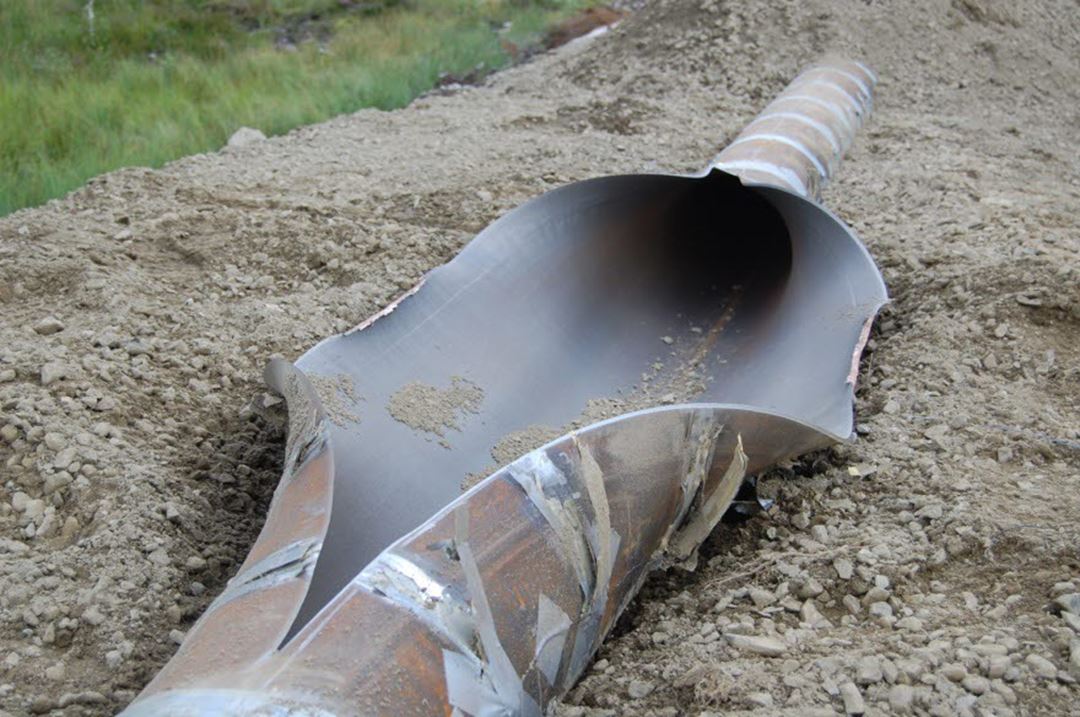
Related publications
- A fracture-propagation-control model for pipelines transporting CO2-rich mixtures including a new method for material-model calibration
Nordhagen, H. O., Munkejord, S. T., Hammer, M., Gruben, G., Fourmeau, M. and Dumoulin, S. | Engineering Structures, In press | 2017 - Fracture propagation control in CO2 pipelines: Validation of a coupled fluid–structure model
Aursand, E., Dumoulin, S., Hammer, M., Lange, H. I., Morin, A., Munkejord, S. T. and Nordhagen, H. O. | Engineering Structures, vol. 123, pp. 192–212 | 2016 - A two-fluid four-equation model with instantaneous thermodynamical equilibrium
Morin, A. and Flåtten, T. | ESAIM: M2AN, vol. 50, pp. 1167-1193 | 2016 - CO2 transport: Data and models – A review
S.T. Munkejord, M. Hammer, S.W Løvseth | Applied Energy, 169, pp. 499-523 | 2016 - Two-phase nozzle flow and the subcharacteristic condition
G. Linga, P. Aursand, T. Flåtten | Journal of Mathematical Analysis and Applications 426, pp. 917–934 | 2015 - CO2 pipeline integrity: Comparison of a coupled fluid-structure model and uncoupled two-curve methods
Aursand, E., Dørum, C., Hammer, M., Morin, A., Munkejord, S. T. and Nordhagen, H. O. | Energy Procedia, vol. 51, pp. 382-391 | 2014 - Main Properties Governing the Ductile Fracture Velocity in Pipelines: A Numerical Study Using an (Artificial Fluid)-Structure Interaction Model
H. Nordhagen, S. Dumoulin, and G. Gruben | Procedia Materials Science, vol. 3, pp. 1650-1655 | 2014 - Method using a density-energy state function with a reference equation of state for fluid-dynamics simulation of vapor-liquid-solid carbon dioxide
Hammer, M., Ervik, Å. and Munkejord, S. T. | Industrial & Engineering Chemistry Research, vol. 52, no. 29, pp. 9965-9978 | 2013 - CO2 Pipeline Integrity: A Coupled Fluid-structure Model Using a Reference Equation of State for CO2
Aursand, E. Aursand, P. Berstad, T. Dørum, C. Hammer, M. Munkejord, T. Nordhagen, O. | Energy Procedia, vol. 37, pp. 3113–3122 | 2013 - Klimaløsning i rør Munkejord, S.T. Mølnvik, M. Dørum, C. | Dagens Næringsliv, 19 April | 2013
- A Roe Scheme for a Compressible Six-Equation Two-Fluid Model
Morin, A. Flåtten, T. Munkejord, S.T. | International Journal for Numerical Methods in Fluids, vol. 72, no. 4, pp. 478-504 | 2012 - Solution of the Span–Wagner equation of state using a density–energy state function for fluid-dynamic simulation of carbon dioxide
Giljarhus, K.E.T. Munkejord, S.T. Skaugen, G. | Industrial & Engineering Chemistry Research, vol. 51, no. 2, pp. 1006-1014 | 2012 - Pipeline flow modelling with source terms due to leakage: The straw method
Morin, A., Kragset, S. and Munkejord, S. T. | Energy Procedia, vol. 23, pp. 226-235 | 2012 - A new coupled fluid–structure modeling methodology for running ductile fracture
Nordhagen, H.O. Kragset, S. Berstad, T. Morin, A. Dørum, C. Munkejord, S.T. | Computers & Structures, vol. 94-95, pp. 13-21 | 2012 - On solutions to equilibrium problems for systems of stiffened gases
Flåtten, T. Morin, A. Munkejord, S. T. | SIAM Journal on Applied Mathematics, vol. 71, no. 1, pp. 41-67 | 2011 - PVTxy properties of CO2 mixtures relevant for CO2 capture, transport and storage: Review of available experimental data and theoretical models
Li, H. Jakobsen, J.P. Wilhelmsen, Ø. Yan, J. | | 2011 - CO2 pipeline integrity: A new evaluation methodology
Berstad, T. Dørum, C. Jakobsen, J. P. Kragset, S. Li, H. Lund, H. Morin, A. Munkejord, S. T. Mølnvik, M. J. Nordhagen, H. O. Østby, E. | Energy Procedia, vol. 4, pp. 3000-3007 | 2011 - Wave propagation in multicomponent flow models
Flåtten, T. Morin, A. Munkejord, S. T. | SIAM Journal on Applied Mathematics, vol. 70, no. 8, pp. 2861-2882 | 2010
CO2Mix: CO2 mixture properties
Overall objective:
To acquire accurate data for thermophysical properties of CO2-rich mixtures at conditions relevant for CCS.
Contribution to one or more of the overall goals/objectives of BIGCCS
CO2 captured in a CCS process will never be absolutely pure. Even small quantities of impurities can significantly affect the thermophysical properties of CO2. Therefore, to be able to design capture processes, transport systems and injection schemes, we need high-quality data for the various impurities in the relevant range of concentrations, pressure and temperature. Presently, there are several white areas on the map, and we aim to fill some of them.
Task 2.2 achievements thus far
- Accurate experimental setups have been constructed to measure the following properties of CO2-rich mixtures
- Vapour-liquid equilibrium
- Density of gas and super-critical phases
- Speed-of-sound of gas and super-critical phases
- All setups are currently conducting measurement campaigns
- Two PhD candidates are being educated
- Three conference articles have been published, and several presentations at scientific conferences held
Phase Equilibrium Cell for CO2 Mixtures (SINTEF ER)
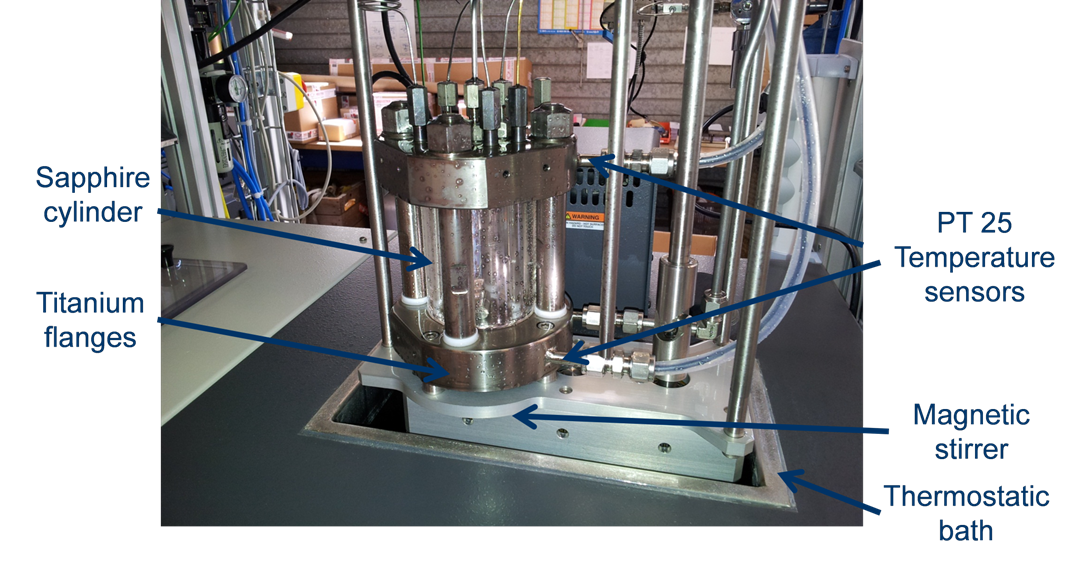
The phase equilibrium setup is using an analytical technique and allows for very precise control of pressure and temperature. The film clip above shows the magic moment of phase separation as the pressure of a CO2-N2 mixture is reduced from supercritical to subcritical.
Density and Speed of Sound Measurements (Ruhr-Universität Bochum)
The speed of sound meter measures the echo time of short acoustic pulses. The density is found by measuring the buoyancy of a single sinker using a magnetic coupling technique developed at RUB. The two apparatuses are connected by the same manifold such that the two properties easily can be measured for the same mixtures.
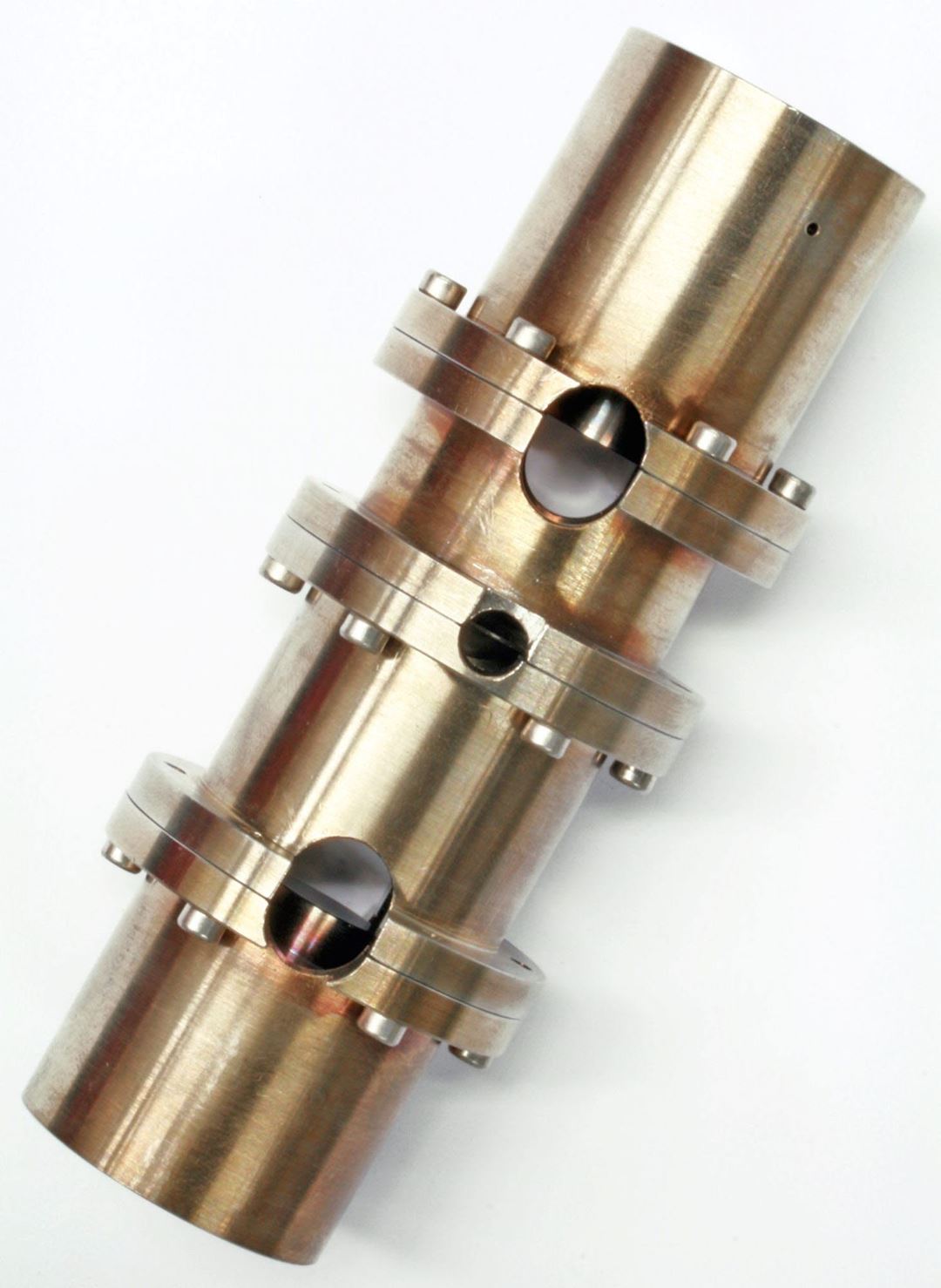
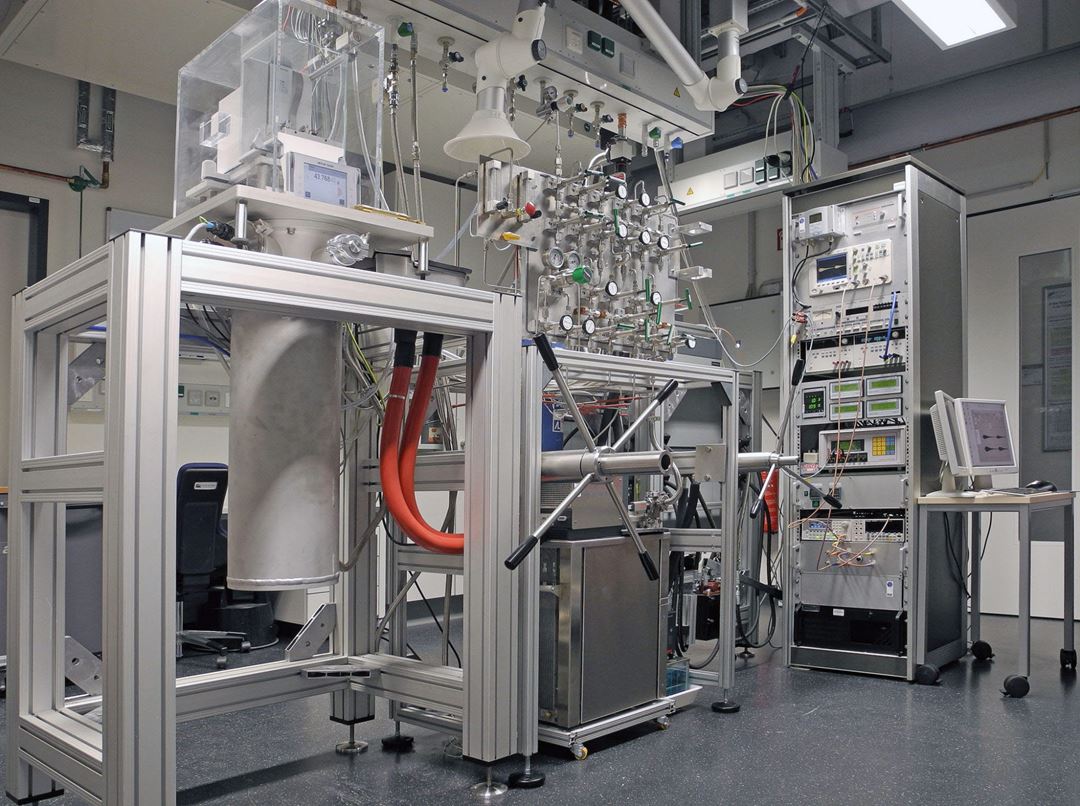
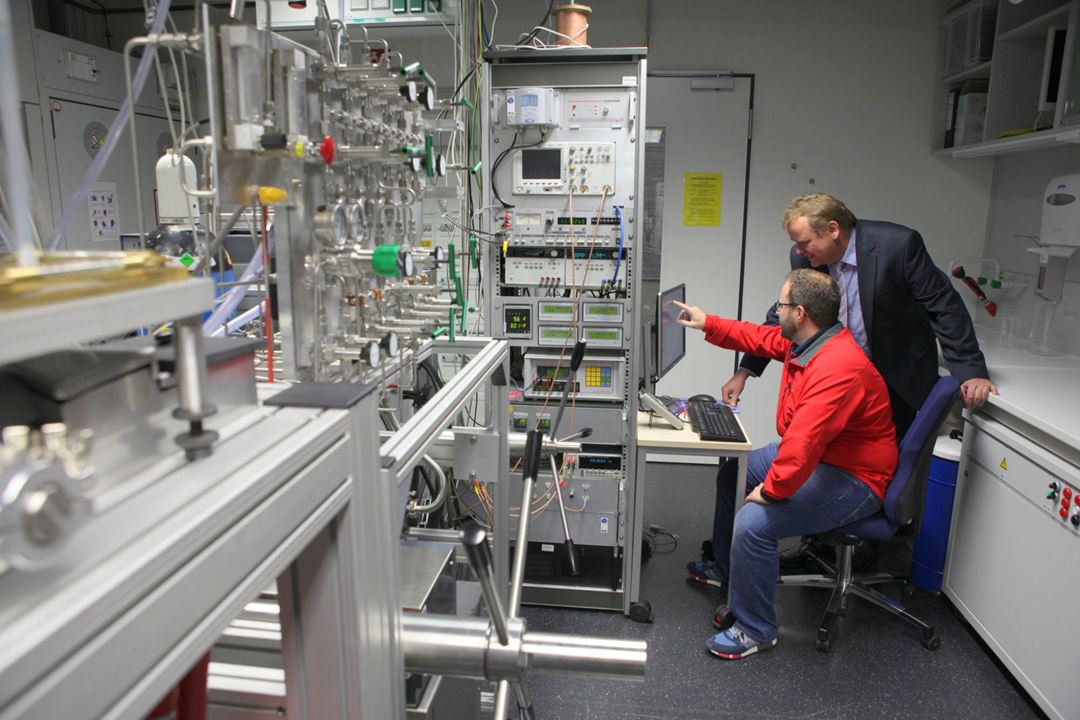
Related publications:
- Vapor-liquid equilibrium data for the carbon dioxide and nitrogen (CO2+N2) system at the temperatures 223, 270, 298 and 303 K and pressures up to 18 MPa
Snorre Foss Westman, H. G. Jacob Stang, Sigurd W. Løvseth, Anders Austegard, Ingrid Snustad, Sigmund Ø. Størset, and Ivar S. Ertesvåg | Fluid Phase Equilibria, v. 409, pp 207-241 | 2016 - CO2 transport: Data and models – A review
S.T. Munkejord, M. Hammer, S.W Løvseth | Applied Energy, 169, pp. 499-523 | 2016 - Vapor-liquid equilibrium data for the carbon dioxide and oxygen (CO2 + O2) system at the temperatures 218, 233, 253, 273, 288 and 298 K and pressures up to 14 MPa
Snorre Foss Westman, Hans Georg Jacob Stang, Sigurd Weidemann Løvseth, Anders Austegard, Ingrid Snustad, Ivar S. Ertesvåg | Fluid Phase Equilibria, v. 421, pp 67-87 | 2016 - Speed-of-sound measurements in (argon + carbon dioxide) over the temperature range from (275 to 500) K at pressures up to 8 MPa
Robin Wegge, Mark O. McLinden, Richard A. Perkins, Markus Richter, Roland Span | The Journal of Chemical Thermodynamics, v. 99, pp 54–64 | 2016 - Measurements of CO2-Rich Mixture Properties: Status and CCS Needs
Sigurd Weidemann Løvseth, Hans Georg Jacob Stang, Anders Austegard, Snorre Foss Westman, Roland Span, Robin Wegge | Energy Procedia, v. 86, pp 469–478 | 2016 - Accurate Phase Equilibrium Measurements of CO2 Mixtures
SF Westman, HG Stang, SØ Størset, H Rekstad, A Austegard, SW Løvseth | Energy Procedia 51, 392-401 | 2014 - Experimental Investigations of Impurity Impact on CO2 Mixture Phase Equilibria
Sigurd Weidemann Løvseth, H.G. Jacob Stang, Snorre Foss Westman, Ingrid Snustad, Anders Austegard | Energy Procedia 63, 2589–2595 | 2014 - Accurate Measurements of CO2 Rich Mixture Phase Equilibria Relevant for CCS Transport and Conditioning
Jacob H. G. Stang, Sigurd W. Løvseth, Sigmund Ø. Størset, Bjarne Malvik, Håvard Rekstad | Energy Procedia 37, 2897-2903 | 2013 - CO2Mix Project: Experimental Determination of Thermo Physical Properties of CO2-Rich Mixtures
Sigurd W. Løvseth, Geir Skaugen, H. G. Jacob Stang, Jana P. Jakobsen, Øivind Wilhelmsen, Roland Span, Robin Wegge | Energy Procedia 37, pp 2888-2896 | 2013
